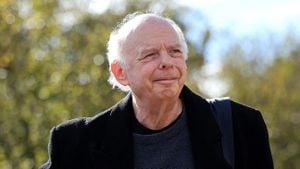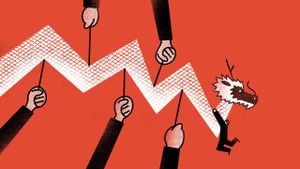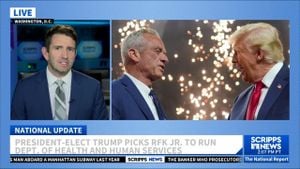President-elect Donald Trump aims to overhaul the federal bureaucracy and cut government spending with the establishment of the new Department of Government Efficiency, or DOGE. This initiative, led by billionaire entrepreneur Elon Musk and former presidential candidate Vivek Ramaswamy, has sparked much debate on its feasibility and potential impact.
Trump announced the formation of DOGE shortly after his victory, indicating it would work to reduce federal waste by streamlining operations and cutting unnecessary regulations. According to reports, Trump stated, "This is going to be something historic." He expressed his desire for significant budget cuts, aiming to save taxpayers up to $2 trillion over the next few years.
Musk, who has previously shown interest in government reform, stated, "We're going to take the chainsaw to the bureaucracy." At the initial rollout event at Mar-a-Lago, Ramaswamy characterized their approach as revolutionary and emphasized the need for "high-IQ small-government revolutionaries" ready to tackle the rigorous demands of government reform.
While the assertiveness of Musk and Ramaswamy resonates with many conservatives, critics quickly raised concerns over the apparent lack of authority and specific guidelines governing DOGE. Since DOGE will not have formal government agency status, many questioned how the panel would effectively implement its cost-cutting initiatives.
Experts like Elaine Kamarck, who previously managed government efficiency projects during the Clinton administration, voiced skepticism. "This is the first warning sign this is going to be a failed operation. That's insane," she commented about Musk's bold claim of finding over $2 trillion to save without defined strategies or metrics to achieve these massive cuts.
Michael Morris, from Columbia Business School, delineated the challenges inherent to top-down government reform. "Unless you have a new leader with incredible legitimacy, the people responding to such shock therapy might be resistant to change. I don't think Musk is going to be able to form deep knowledge of government operations." With DOGE being formed by outsiders unfamiliar with governmental processes, the venture's success hinges on acquiring trust and cooperation from within the system.
Despite uncertainties about how much actual power the DOGE group will wield, both Musk and Ramaswamy have begun soliciting public submissions on identified instances of wasteful government spending. This initiative utilizes the social media platform X (formerly Twitter) to broaden their outreach and engage with citizens on the changes they envision.
Initially, potential applicants were required to be premium X subscribers to reach out to DOGE for job opportunities, which sparked criticism from users. Many underscored the irony of needing to pay for a subscription to participate actively in reducing government spending.
With the ambitious objective set to be completed by July 4, 2026, the 250th anniversary of the Declaration of Independence, the urgency is palpable. Musk insists on transparency throughout the process, promising frequent updates and public engagement on the expenditure and decision-making front.
While Trump's vision of government efficiency may excite his supporters, Democratic lawmakers and various public service watchdogs remain apprehensive about this unconventional approach. Their sentiments reflect concern over whether DOGE can make meaningful changes without the approval and engagement of Congress, which retains ultimate authority over federal budgeting.
The focus on transparency and public input aligns with broader calls for increased accountability within government spending; nevertheless, the manner and feasibility surrounding Musk and Ramaswamy's initiative remain hotly contested topics.
The historical precedent for government efficiency initiatives is mixed, as both past Republican and Democratic administrations have grappled with budget constraints and bureaucratic challenges. Trump’s earlier attempts to cut numerous agencies during his first term were met with considerable pushback, making the current endeavor seem like yet another uphill battle.
Both Musk and Ramaswamy have yet to clearly outline the specifics of the programs and departments targeted for cuts. While entrepreneurial flair and innovative thinking are valuable, experts posit these approaches must be anchored by grounded policies capable of gaining bipartisan agreement to manifest real, sustainable change.
At this early stage, DOGE’s discourse suggests it aims to tackle large portions of federal bureaucracy, targeting agencies deemed redundant or ineffective. Trump has consistently referred to "draining the swamp" as part of his electoral commitments, implying significant restructuring within various agencies without detailing the complexity involved.
There’s much speculation about the economic ramifications if DOGE advances with its plans. Musk has posited the necessity for cuts, aligning his presidential campaign rhetoric with the ideological belief of sustaining fiscal prudence. Still, such suggestions must balance the potential hardship inflicted on citizens reliant on government services.
Most recently, Ramaswamy highlighted issues like persistent appropriations toward outdated programs, echoing calls for straightforward eliminations to streamline government expenditures. He suggested delving deep to identify wasteful allocations—"We can save hundreds of billions each year by defunding programs no longer authorized by Congress!" he proclaimed.
These discussions paint DOGE as ambitious; nonetheless, it becomes increasingly clear its success will depend heavily on Congress's willingness to act and engage without being blindsided by unconventional methods of reform.
Despite the array of enthusiasm from Trump’s base, the skepticism from insiders and commentators indicates significant challenges await as Musk and Ramaswamy strive to transform the dogma of government effectiveness. This is certainly one story to watch as it develops—not just for its intended goals of efficiency but for the complex dynamics at play within the hallowed halls of federal governance.



